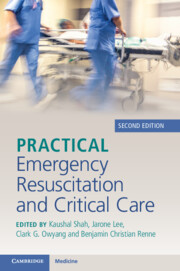Book contents
- Practical Emergency Resuscitation and Critical Care
- Practical Emergency Resuscitation and Critical Care
- Copyright page
- Contents
- Contributors
- Preface
- Section 1 General Critical Care
- Section 2 Infectious Disease Emergencies
- Section 3 Neurological Emergencies
- Section 4 Cardiovascular Emergencies
- Section 5 Respiratory Emergencies
- Section 6 Gastrointestinal Emergencies
- Section 7 Renal Emergencies
- Section 8 Hematology–Oncology Emergencies
- Section 9 Endocrine Emergencies
- Section 10 Environmental Emergencies
- Section 11 Trauma
- 47 General Trauma Principles
- 48 Severe Traumatic Brain Injury
- 49 Neck Trauma
- 50 Thoracic Trauma
- 51 Solid Organ Abdominal Trauma
- 52 Severe Pelvic Trauma
- 53 Soft Tissue Injury
- 54 Burn Resuscitation
- Section 12 End of Life
- Index
- References
53 - Soft Tissue Injury
Crush Injury, Compartment Syndrome, and Open Fractures
from Section 11 - Trauma
Published online by Cambridge University Press: 02 November 2023
- Practical Emergency Resuscitation and Critical Care
- Practical Emergency Resuscitation and Critical Care
- Copyright page
- Contents
- Contributors
- Preface
- Section 1 General Critical Care
- Section 2 Infectious Disease Emergencies
- Section 3 Neurological Emergencies
- Section 4 Cardiovascular Emergencies
- Section 5 Respiratory Emergencies
- Section 6 Gastrointestinal Emergencies
- Section 7 Renal Emergencies
- Section 8 Hematology–Oncology Emergencies
- Section 9 Endocrine Emergencies
- Section 10 Environmental Emergencies
- Section 11 Trauma
- 47 General Trauma Principles
- 48 Severe Traumatic Brain Injury
- 49 Neck Trauma
- 50 Thoracic Trauma
- 51 Solid Organ Abdominal Trauma
- 52 Severe Pelvic Trauma
- 53 Soft Tissue Injury
- 54 Burn Resuscitation
- Section 12 End of Life
- Index
- References
Summary
Severe crush injury can result in sequelae such as significant bony fractures, rhabdomyolysis, extremity compartment syndrome or crush syndrome. Crush syndrome comprises the systemic manifestations that arise as a result of a crush injury followed by reperfusion. From the rupture of muscle cells, substances such as myoglobin, potassium, phosphorus and creatinine phosphokinase are released into the bloodstream. The patient can subsequently develop hyperkalemia, hypocalcemia, hypovolemia, shock, compartment syndrome, lactic acidosis or renal failure from traumatic rhabdomyolysis (seen in up to 40% of patients with crush injury).
- Type
- Chapter
- Information
- Practical Emergency Resuscitation and Critical Care , pp. 567 - 577Publisher: Cambridge University PressPrint publication year: 2023

